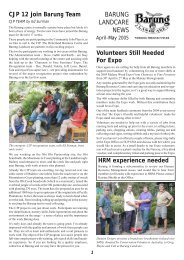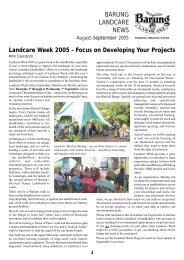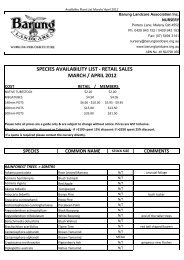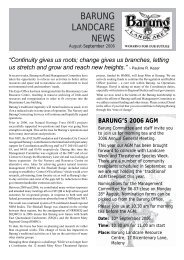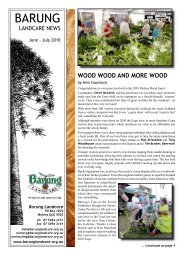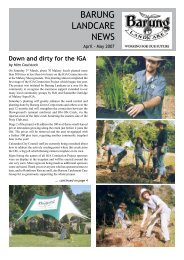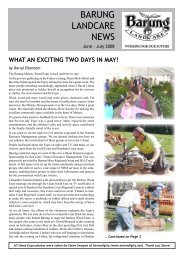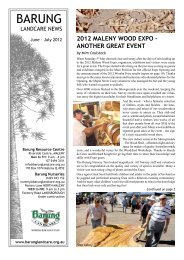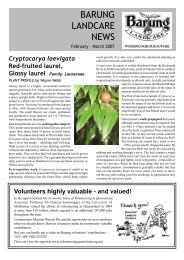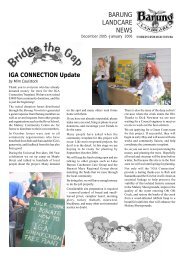Jun/July 2005 - Barung Landcare
Jun/July 2005 - Barung Landcare
Jun/July 2005 - Barung Landcare
- No tags were found...
Create successful ePaper yourself
Turn your PDF publications into a flip-book with our unique Google optimized e-Paper software.
Flindersia schottiana<br />
BUMPY ASH (Family: Rutaceae)<br />
PLANT PROFILE by<br />
Wayne Webb<br />
A large rainforest tree growing to<br />
around 40 metres high in riverine<br />
and subtropical rainforests,<br />
Flindersia schottiana is common<br />
in the Maleny area as a paddock<br />
tree to around half this height.<br />
These trees were conspicuous in<br />
early summer with their heavy<br />
flowering of white honey-scented<br />
flowers in large terminal panicles.<br />
Individual flowers are about 8 mm<br />
in diameter. Flowers are followed<br />
by spiky seed pods to 10 cm long<br />
Flindersia schottiana near<br />
Cairncross Corner<br />
by 4 cm wide. They are green when immature, but go woody and<br />
open when mature to adorn the tree in creamy white stars. They<br />
separate into five boat-shaped valves, each containing a woody<br />
partition with three seeds on each side. The seeds are winged and<br />
are released in January and February. Seeds germinate readily<br />
when sown fresh on propagation mix and covered lightly.<br />
Leaves are large, opposite and pinnate, with 9 to 19 leaflets.<br />
Leaflets are 7 to 15 cm long on mature trees, although they can be<br />
much larger on young trees. Leaves have distinct oil dots. Foliage<br />
tends to be rather sparse, with a somewhat layered canopy.<br />
Also called cudgerie or silver ash, bumpy ash grows from the<br />
mid-north coast of New South Wales to the Iron Range in north<br />
Queensland. It also grows in Papua New Guinea and Irian Jaya.<br />
Locally, bumpy ash is very common on the Blackall Range as an<br />
important component of most remnant and regrowth vegetation.<br />
Its range extends down the eastern side of the range as a component<br />
of riparian vegetation, and also down into the Conondale valley.<br />
Flindersia schottiana is a key species for rainforest revegetation.<br />
It is an important long-lived species in mature rainforest, but it is<br />
also fast-growing and hardy enough to be regarded as a pioneer<br />
species. It will grow quite well in full sun and is tolerant of<br />
moderate frost. It is also a good tree to plant as a shade tree in an<br />
acreage garden or paddock.<br />
Bumpy ash is known as silver ash in<br />
the timber trade. Both sapwood and<br />
heartwood are pale yellow with a<br />
straight grain. It is fairly durable and<br />
suitable for cabinet work, flooring,<br />
lining and indoor fittings. Flindersia<br />
schottiana is widely planted in cabinet<br />
timber plots due to its hardiness, fast<br />
growth rate, and ability to produce a<br />
straight trunk.<br />
Flindersia schottiana will be on<br />
special at the <strong>Barung</strong> Nursery<br />
during <strong>Jun</strong>e & <strong>July</strong> @ $1.50.<br />
Illustration from Fragments of Green by Janet Hauser & Jan<br />
Blok, Australian Rainforest Conservation Society<br />
EFTPOS facility<br />
available at <strong>Barung</strong> <strong>Landcare</strong><br />
9<br />
Expo triumph<br />
NURSERY NOTES by Wayne Webb<br />
Looking back over the last couple of months it’s hard to think of<br />
anything but EXPO. This year’s nursery tent was a great success.<br />
The spectacular garden display created by Greg Smyrell (with<br />
help from the CJP team) drew a lot of comment, and provided a<br />
beautiful backdrop to the plant sales area. Thanks to CalAqua for<br />
the sponsorship to set up the display as a demonstration of<br />
waterwise gardening techniques. Thanks also to The Range<br />
Hardware & Hire for the loan of a garden pond, to Tenkate<br />
Landscape Supplies for donating various mulches, rocks and<br />
topsoil to use in the display, and to the Council for a truckload of<br />
mulch. The garden showed a range of techniques which can be<br />
employed to maximise the benefit of rainfall (such as soil profiling<br />
and dry creek beds with gravel absorption pits) and to minimise<br />
the loss of moisture from the soil (eg mulching, shading the soil<br />
by dense planting, and screening from drying winds). The greatest<br />
considerations are the choice of plant species and the style of<br />
landscape. Local plant species in a natural style of landscaping<br />
require almost no watering once established, whereas a garden<br />
designed around beds of annuals requires frequent watering.<br />
Thanks also to our local councillor Dick Newman for sponsoring<br />
the hire of a data projector to display images of our local fauna<br />
and the flora they depend on. Thanks to Wayne Ellis and Bob<br />
Miller for the use of their fantastic photographs. This and Greg’s<br />
garden combined to give the nursery tent a great ambience which<br />
was enjoyed by a constant stream of people over the weekend.<br />
Sales for the weekend were up over 25 per cent on last year. A big<br />
thank you from Cali and me to all the volunteers who helped out<br />
in the tent over the weekend, and to the CJP team for their<br />
invaluable assistance in setting up and pulling down.<br />
The dust hadn’t settled from expo when Trish suggested revamping<br />
the entrance to the <strong>Barung</strong> office. CJPer Jeff sprung into action,<br />
unleashing his creative talents with paving, garden edging and a<br />
new sitting area off to the side – looks great, come check it out!<br />
In April, a visit to the nursery and a seed collection walk by students<br />
of Conservation & Land Management (Cert 3) at Nambour TAFE<br />
was a excellent way to establish links with others in the field.<br />
Don’t forget, anyone with excess plastic shopping bags is welcome<br />
to bring them into the nursery for reusing.



